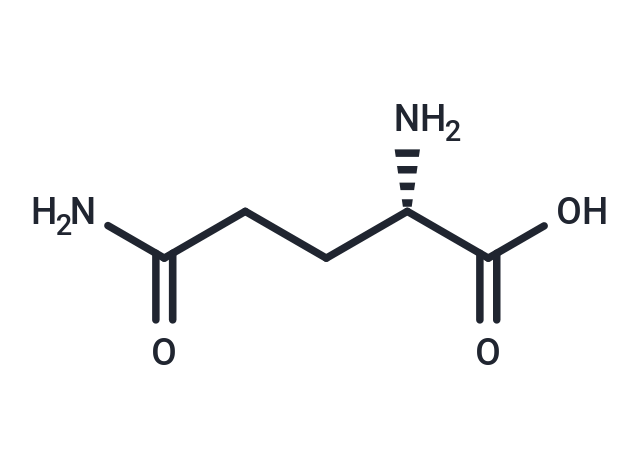Shopping Cart
Remove All Your shopping cart is currently empty
Your shopping cart is currently empty
L-Glutamine (L-Glutamic acid 5-amide) is a non-essential amino acid that exists in large quantities in the human body and participates in many metabolic processes. L-Glutamine provides a carbon source for oxidation in certain cells.

| Pack Size | Price | USA Warehouse | Global Warehouse | Quantity |
|---|---|---|---|---|
| 5 g | $29 | - | In Stock | |
| 1 mL x 10 mM (in H2O) | $50 | In Stock | In Stock |
| Description | L-Glutamine (L-Glutamic acid 5-amide) is a non-essential amino acid that exists in large quantities in the human body and participates in many metabolic processes. L-Glutamine provides a carbon source for oxidation in certain cells. |
| Targets&IC50 | mGluR7:19 μM |
| In vitro | L-Glutamine (0.2 and 2 mM) but not D-Gln inhibits the generation of L-Arg by both Arg-depleted and nondepleted endothelial cells. L-Glutamine also inhibits the conversion of L-[14C]Cit to L-[14C]Arg by Arg-depleted endothelial cells. L-Glutamine interferes with the conversion of L-Cit to L-Arg probably by acting on argininosuccinate synthetase rather than argininosuccinate lyase. L-Glutamine also inhibits the generation of L-Arg by the monocyte-macrophage cell line J774 but has no effect on the conversion of L-Cit to L-Arg by these cells. [1] L-Glutamine metabolism stimulates Na+-H+exchange of acid-loaded porcine enterocytes by a mechanism not requiring activation of PKC. [2] L-Glutamine (0.2 mM and 2 mM) but not D-glutamine (2 mM), L-glutamic acid (2 mM) or ammonium chloride (1 mM) also inhibits the generation of L-arginine in endothelial cells. [3] L-glutamine promotes chromatin condensation and formation of crescent-like structures in the nucleus of murine primary microglia as well as of the microglial cell-line BV-2. [4] |
| In vivo | L-Glutamine at 0.5, 2 and 5 mM dose-dependently reduces H(2)O(2)- or LPS-induced cell death by 14%, 54% and 95%. L-Glutamine increases Glutamine concentrations in small-intestinal lumen and plasma, reduces intestinal expression of Toll-like receptor-4, active caspase-3 and NFkB, ameliorates intestinal injury, decreases rectal temperature, and enhanced growth performance in LPS-challenged piglets. [5] |
| Synonyms | L-Glutamic acid 5-amide |
| Molecular Weight | 146.14 |
| Formula | C5H10N2O3 |
| Cas No. | 56-85-9 |
| Smiles | [C@H](CCC(N)=O)(C(O)=O)N |
| Relative Density. | 1.469 g/cm3. Temperature:20 °C.;1.469. Temperature:20 °C. |
| Color | White |
| Appearance | Solid |
| Storage | store at low temperature | Powder: -20°C for 3 years | In solvent: -80°C for 1 year | Shipping with blue ice/Shipping at ambient temperature. | |||||||||||||||||||||||||||||||||||
| Solubility Information | DMSO: Insoluble H2O: 40.7 mg/mL (278.5 mM), Sonication and heating are recommended. | |||||||||||||||||||||||||||||||||||
Solution Preparation Table | ||||||||||||||||||||||||||||||||||||
H2O
| ||||||||||||||||||||||||||||||||||||
| Size | Quantity | Unit Price | Amount | Operation |
|---|

Copyright © 2015-2025 TargetMol Chemicals Inc. All Rights Reserved.